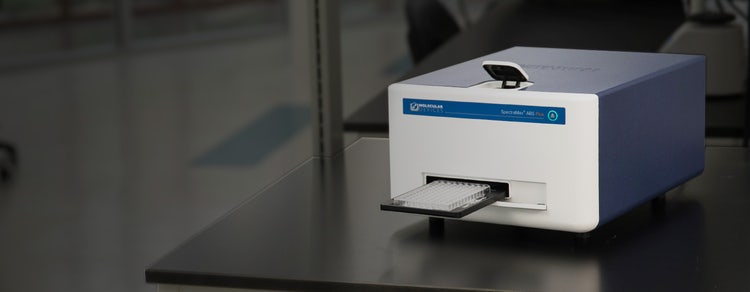

SpectraMax ABS and ABS Plus Absorbance ELISA Microplate Readers
Fast and compact absorbance microplate readers for a wide range of assays without the use of filters
Filterless readers provide consistent results with steady temperature regulation
The SpectraMax® ABS and ABS Plus absorbance microplate readers provide the flexibility, sensitivity, and convenience for a wide range of assays such as ELISAs, microbial growth, and protein quantitation. Both readers feature an 8-channel read head for fast reads and a subset feature, the temperature independent PathCheck sensor that automatically normalizes and ensures accurate absorbance values by detecting pipetting errors. Combined with a wide application base, industry-leading SoftMax® Pro Software and validation tools, these readers fit in every lab and every budget.

Eliminate filters
Eliminate the need for purchasing and changing out filters with a monochromator-based wavelength selection for visible and UV-visible absorbance.

Get consistent results
Mix samples thoroughly in microplate wells with user-programmable Automix feature and monitor temperature-sensitive reactions with consistent temperature regulation from ambient to 45°C.

Integrate with ease
Measure micro-volumes: Compatible with the SpectraDrop™ Micro-Volume Microplate, enabling high-throughput measurement of low volumes (<5um) – ideal for DNA, RNA and protein quantification.

SpectraMax ABS Plus Feature Demonstration
Features

Pipetting errors eliminated
This reader utilizes Molecular Devices' temperature independent PathCheck Sensor technology to measure the depth (optical pathlength) of samples in a microplate. It also allows for the elimination of standard curves.

Optimized optical path
The reader’s unique quartz fiber optic system minimizes stray light for precise readings across a microplate. The spectral resolution ensures accuracy of DNA absorbance measurements.

Eight-channel optics
The optical design of the reader enables simultaneous detection of 8 wells. The eight-channel system delivers both precision and speed across the microplate.

Dual wavelength reads
The reader delivers high performance with round-bottom, flat-bottom or half-area well plates. Dual wavelength readings report the actual absorbance at each wavelength making data analysis convenient.

Flexibility to read a variety of plate formats
SpectraMax® Absorbance Microplate Readers can run both cuvette-based and microplate reader applications on the same instrument. Read one sample or up to 384 in a single plate read using any standard cuvette, or 96- or 384-well microplate.

Validation made easy
Verify the accuracy of your absorbance measurements with the SpectraTest® ABS1 Absorbance Validation Plate, using NIST-traceable standards. Testing can be done in your own lab, on your own schedule.
Latest Resources
Featured Applications
Customer Breakthrough
Applications of SpectraMax ABS and ABS Plus Absorbance ELISA Microplate Readers
Specifications & Options of SpectraMax ABS and ABS Plus Absorbance ELISA Microplate Readers
*Using lowest settings and speed read when available.
**Only available on SpectraMax ABS Plus.
Download Data Sheet

Resources of SpectraMax ABS and ABS Plus Absorbance ELISA Microplate Readers
Absorbance Microplate Readers
SpectraMax® ABS Plus Microplate Reader
SpectraMax® ABS Microplate Reader
SpectraMax® 340PC384 Microplate Reader
SpectraMax® Plus 384 Microplate Reader
SpectraMax® 190 Microplate Reader
VersaMax™ ELISA Microplate Reader